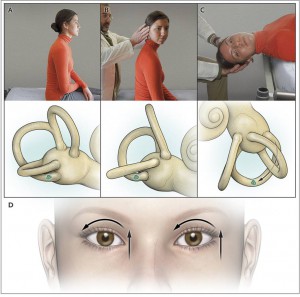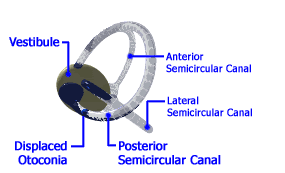BPPV
Benin paroxysmal positional vertigo (BPPV). This is the most common type of vertigo. This is a short period rotatory vertigo not exceeding a few seconds, triggered by a change of position like by turning from side to side in bed, by moving the head to look up or down, by leaning down to pick up something on the floor …
Although the rotation phase lasts no more than a few seconds, the patient may bring instability that lasts a few minutes after the rotary phase. BPPV is repeated several times a day, often associated with nausea, but is rarely accompanied by vomiting.
It is due to the dislodging of otoconia (crystals) form their usual position within the macula of the utricle. These released otoconia migrate most frequently in the posterior semicircular canal; with each change of position, the otoconia move in the endolymph (fluid in the inner ear) and cause a turbulence of the liquid. This liquid turbulence irritates the balance cells and gives the spinning sensation and dizziness. Imagine a bottle full of water with some sand inside; by turning the bottle upside down, the sand falls to the bottom of the bottle and creates water turbulence.

Your doctor confirms the diagnosis by performing the Dix-Hallpike test. When it is positive and in its typical forms, it does not carry out further examination. In atypical forms, ask the advice of a neurotologist (ORL specialized in vertigo) or a neurologist. An MRI to rule out pathology of the brain stem should be asked.
Spontaneous recovery of BPPV is possible in 15% of cases. Otherwise, consult our experts at the Polyclinique Centre-Ville ORL & Spécialités Médicales. BPPV is treated by adequate repositioning maneuvers. No medication should be prescribed for BPPV; it is treated by one of the two repositioning maneuvers: Epley maneuver or Semont maneuver.

_____________________________________
Anatomy and Function of the labyrinth
Definition
Do you have vertigo? An imbalance?
Benin Paroxysmal Positional Vertigo (BPPV)
Meniere’s disease
Neuronitis or vestibular neuritis
Labyrinthitis
Dehiscence of the superior canal
Cervical dizziness
Perilymphatic fistula
Migraine and vertigo / Vestibular Migraine
Basilar migraine and vertigo
Vertigo of central origin
Psychogenic vertigo
Vertebrobasilar insufficiency and imbalance
